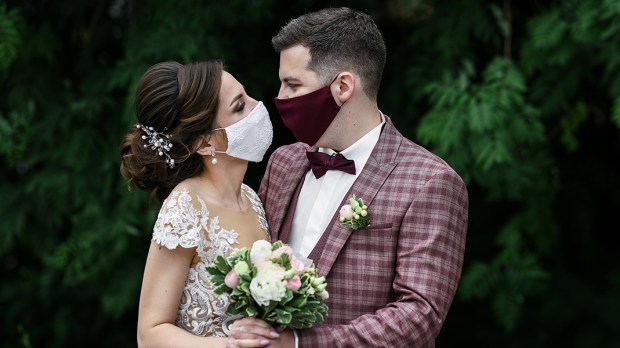Can a Catholic have two weddings? This is a question that’s come up of late, as couples have had to cancel their plans for large church weddings due to the coronavirus pandemic.
To answer this question, let’s start by looking at how the Church, via the Code of Canon Law, defines marriage in the first place. Canon 1057 §1 tells us that: “The consent of the parties, legitimately manifested between persons qualified by law, makes marriage”; and §2 of this same canon indicates that: “Matrimonial consent is an act of the will by which a man and a woman mutually give and accept each other through an irrevocable covenant in order to establish marriage.”
A true wedding—that is, a ceremony in which a marriage actually begins—is essentially the same thing as this exchange of consent. Once this consent is really exchanged, it is binding and enduring for life. The exchange of consent cannot be “re-done,” because it is not “re-doable,” on account of its fundamental permanence. Given this, from a Catholic perspective it is not possible to have two weddings, since the wedding of two specific individuals is, by its very nature, a once in a lifetime event.
Civil marriage vs. canonical form
However, one important nuance in this discussion is the requirement for Catholics to marry “according to canonical form,” i.e., in a Catholic wedding ceremony, in order for the marriage to be valid. If a Catholic marries in a non-Catholic ceremony without a special dispensation from the local bishop, that marriage is not considered valid or recognized by the Church. This is true even though the local secular state government might recognize the marriage according to its own qualifications.
Sometimes, baptized Catholics, who perhaps drifted away from the faith in their youth, find themselves in merely civil (and thus canonically invalid) marriages, but feel called to return to the practice of their faith and to the Church. When situations like this occur, in order to bring their marital relationship in accord with Church teachings, such couples will need to regularize their union. To do this, they must exchange marital consent before a priest or deacon, according to canonical form.
Often this is done in a very low-key ceremony, which may be popularly referred to as “having the marriage blessed” or as a “convalidation”—although neither of these terms is technically correct in a strict canonical sense, since what is really happening is an actual wedding. But while this might be subjectively experienced by the parties involved as a sort of “second wedding,” in the eyes of the Church it is actually the first and true wedding.
In the United States, the secular state government recognizes religious weddings as binding even according to our civil laws. For example, when American Catholics marry in their parish church, they are considered married not only according to the Church, but they are also automatically acknowledged as married by the state.
Yet this is not the case in every country. In those countries where religious marriages aren’t recognized as binding civilly, Catholic couples will need to exchange consent according to canonical form, and also exchange consent before a government representative in a separate instance. Still, the same principle mentioned above applies here as well: in the eyes of the Church, there was only one actual wedding, which for Catholics is the exchange of consent according to canonical form.
What about non-Catholics?
Non-Catholics, whether they are baptized Christians from other denominations or non-baptized non-Christians, are not bound to canonical form as Catholics are. This means that a non-Catholic can marry validly in a non-religious context, such as before a Justice of the Peace.
However, aside from the purely disciplinary issue of canonical form, for the most part the Church’s teachings on marriage are universal, as they are based not on arbitrary rules but rather on the nature of spousal relationships and, more broadly, on what it fundamentally means to be human.
For non-Catholics, a marriage is also contracted by the couple’s exchange of consent, and this consent is likewise understood to be a one-time, permanent commitment. So although a non-Catholic may have two “weddings,” only one of those ceremonies would have been the valid, true wedding.
Pastoral considerations
What about circumstances where a Catholic might have reasonable motives for wanting two separate wedding ceremonies? For instance, during the height of the recent pandemic restrictions, many couples chose to have very small weddings with fewer than 10 people present, but still understandably wanted a larger celebration with friends and family once this became possible. Would a “second wedding” be appropriate in a case such as this?
In general, since the Church sees matrimonial consent as permanent and unrepeatable, so-called “second weddings” are not permissible. Even if the couple understood that their second ceremony was not in fact an actual wedding, our faith calls us to live our lives in a spirit of reality, sincerity, and truth. Having a post-wedding event that was essentially a “pretend wedding” misrepresents the uniquely permanent nature of the marriage convent.
However, there is nothing in canon law that requires a wedding reception to occur immediately after the wedding itself! Having a party to celebrate a marriage that is understood by all as having already occurred is perfectly legitimate. There is also nothing to prevent a recently married couple from celebrating their marriage at a gathering where they re-wear their wedding clothes, serve traditional wedding food, or pray together with family and friends asking God to bless the new nuptial union they have already begun.

